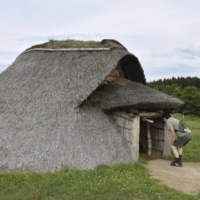A UNESCO advisory panel on Wednesday recommended that the Jomon Period (10,000-200 B.C.) archeological sites in northern Japan be added to the World Cultural Heritage list.
The group is comprised of 17 ancient sites across Hokkaido, Aomori, Iwate and Akita prefectures that are reflective of a hunter-gatherer society that prevailed in Japan for more than 10,000 years.
If registered during an online World Heritage Committee session between July 16 and 31, the locations will be Japan’s 20th World Cultural Heritage listing.
Among the ruins, the Sannai Maruyama village in Aomori, which dates back around 5,900 years, features a large settlement with the remains of large buildings and roads arranged systematically. The Oyu Kanjo Resseki site in Akita, meanwhile, consists of a pair of large stone circles.
The Japanese government recommended the archeological sites to the U.N. Educational, Scientific and Cultural Organization in 2020, saying they represent an era that is believed to have begun 16,000 years ago with settlements based on hunting, fishing and plant gathering on the back of abundant food resources.
Earlier this month, the UNESCO advisory panel recommended a chain of islands in southwestern Japan with dense subtropical forests to be added to the list of natural World Heritage sites.
In a time of both misinformation and too much information, quality journalism is more crucial than ever.
By subscribing, you can help us get the story right.
SUBSCRIBE NOW



